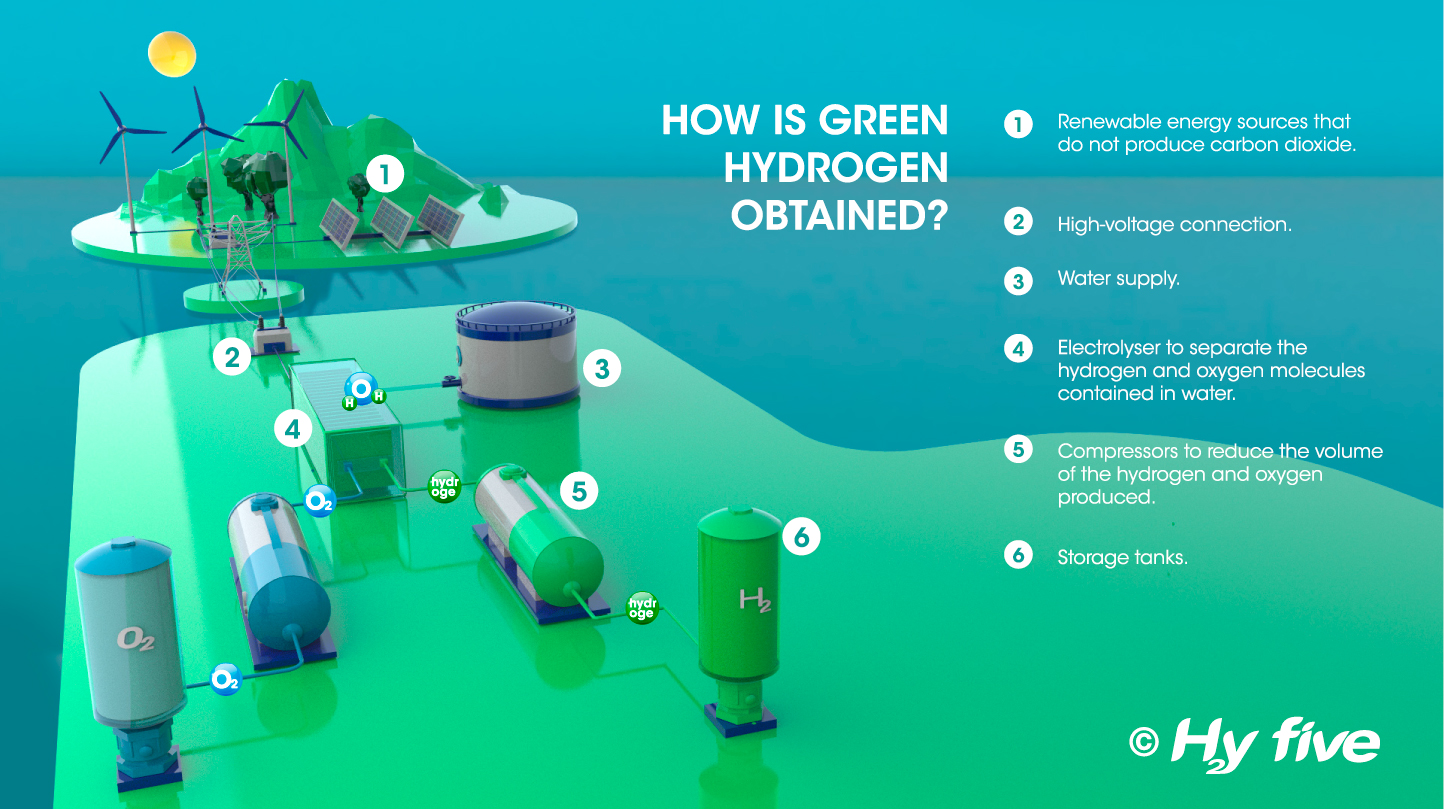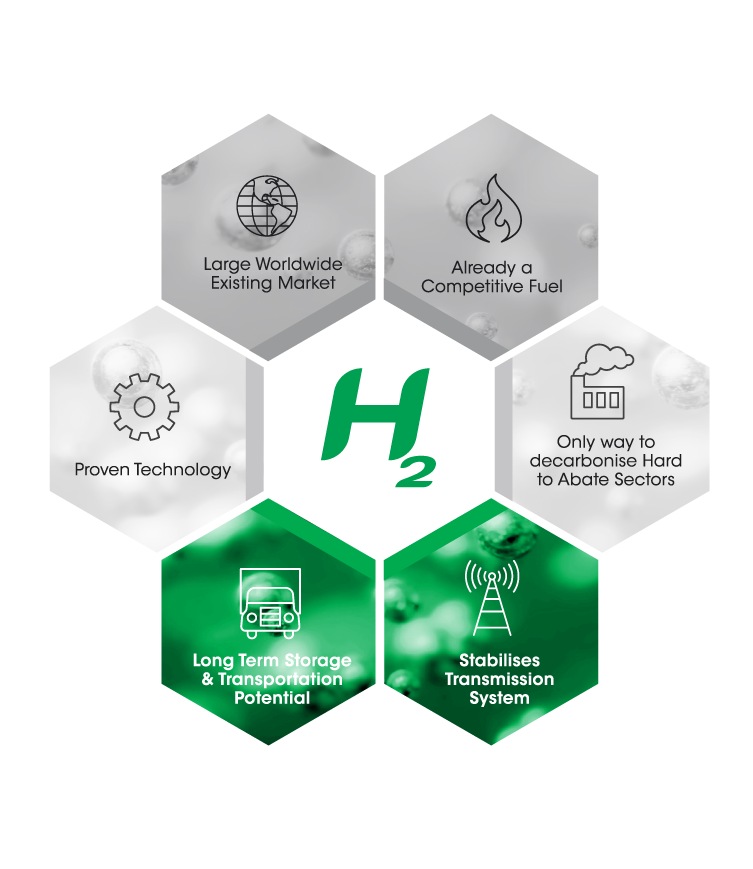GREEN HYDROGEN, THE CLEAN ENERGY THAT WILL CHANGE THE WORLD
WHAT IS “GREEN HYDROGEN”?
If we split a water molecule using an electric current, we will get hydrogen (H2) and oxygen (O). This electric current is produced by a device known as an electrolyzer, which, if powered by a renewable energy source such as wind or solar, the hydrogen generated doesn’t involve any greenhouse gas emissions, and it’s often referred to as green hydrogen.
The resulting hydrogen is a clean and sustainable fuel with zero pollution index that can be used not only as an energy vector but also as a raw material.
The greatest value of green hydrogen in the fight against climate change resides in its ability to replace fossil fuels in sectors such as industry, transport, and power generation that were previously more difficult to decarbonise.
It also has a big potential as an energy storage system, offering an energy supply that is not jeopardized by adverse weather conditions, unlike other technologies.
All of these characteristics of hydrogen make it key to energy decarbonisation and the fight against climate change, one of the goals set by the United Nations in its Sustainable Development Goals (SDGs) at the 2015 United Nations Climate Change Conference.
The future market for this tiny molecule is huge.
Fuel for:
Heat for:
Feedstock for:
Transport
Terrestrial
Maritime
Air
Industry
Steel | Cement
Paper | Food
Aluminium
Chemicals
Fertilizers
Fuel refiling
Plastics
Power
Electricity
Peaking plants
Buildings
Residential & Commercial
Metallurgy | Food
Steel | Glass
HOW IS GREEN HYDROGEN OBTAINED?
Green hydrogen is produced using a technology known as electrolysis, a term derived from the greek words electron = electricity and lysis= to break apart or decompose. The process involves passing an electric current through water using a device known as an electrolyser. This separates the hydrogen from the oxygen. If the energy used for this process comes from renewable sources, the output is known as green hydrogen or renewable hydrogen.
However, if the energy comes from burning fossil fuels, the resulting compound is called grey hydrogen.


GREEN HYDROGEN IS THE MISSING PIECE OF THE DECARBONISATION PUZZLE
Today, the world produces 75 million tons of hydrogen every year, most of which is generated from fossil fuels, mainly natural gas and coal. This results in 830 million tons of carbon dioxide being released into the atmosphere each year.
However, if we produce all of this hydrogen with green energy, we will substantially reduce CO2 emissions.
GREEN HYDROGEN IS ALREADY COMPETITIVE FOR MANY DIFFERENT APPLICATIONS
As the hydrogen industry scales-up over the next decade, green hydrogen will become competitive for more and more end-uses reaching its full potential. Already today, the current size of potential green hydrogen market is at c. €45bn/year considering diesel substitution at competitive prices. This is especially true in the transportation sector, where autonomy, heavy weight, high vehicle usage or charging speed are key: long-range trucks, heavy trucks, taxi fleets, commercial van fleets, forklifts, heavy-duty mobility etc.
Green hydrogen is much more than just hydrogen
Many existing sources of energy can be substituted by combining captured CO2 and green hydrogen.
Current demand of Green Hydrogen
Oil Refining
Ammonia Production
Methanol
Other Chemical Processes
Steel Production
Mobility (buses)
Hydrogen Market Today and in the Medium Term 2024-28
Decarbonisation of today applications through green H2
Mobility: Trains, forklifts, buses, taxis, other services
Maritime
New Hydrogen Market >28
Gas Network Bending
Back Up Generation
High-temperature Industry
Furnace Boilers
High Value Chemicals
Synfuels
SAF
Current demand of Green Hydrogen
Hydrogen Market Today and in the Medium Term 2024-28
New Hydrogen Market >2028
Oil Refining
Ammonia Production
Methanol
Other Chemical Processes
Steel Production
Mobility (buses)
Decarbonisation of today applications through green H2
Mobility: Trains, forklifts, buses, taxis, other services
Gas Network Bending
Back Up Generation
High-temperature Industry
Furnace Boilers
High Value Chemicals
Synfuels
SAF
The Role of Green Hydrogen
By 2040, the estimated global energy demand will increase between 25% and 30%. It’s evident that our way of life needs an increasing amount of watts in order to function, and our current economy depends on coal and oil, which translates into more CO2 emissions.
Decarbonising the planet is one of the main global targets set for 2050. In order to achieve this goal, a number of actions need to be taken and regulatory frameworks that incentivize investments need to be created.
In this context, green hydrogen emerges as the strongest candidate for decarbonising sectors less dependent on electricity, advancing a step closer in the race to carbon neutrality.
Green Hydrogen is a critical enabler of the global transition to sustainable energy and a zero emissions economy.
Benefits of Green Hydrogen
Green Hydrogen is one of the key players in the imminent energy transition led by the world’s main economies in an effort to achieve carbon neutrality and combat climate change. Some of green hydrogen’s benefits include:
- It is a clean energy: the only waste it generates is water.
- It is a renewable energy: it uses natural resources that do not run out. The three main sources of energy needed for the production of green hydrogen are water, wind and the sun.
- It’s storable: green hydrogen can be compressed and stored in ad hoc tanks for a long period of time.
- Green hydrogen is also transportable: since it is a very light element, compressed hydrogen tanks are easier to handle than lithium batteries, because they are lighter and, consequently, easier to transport.
- Hydrogen is a very abundant element, and its supply is virtually limitless. Thus, wherever there’s water and electricity, green hydrogen can be produced in order to generate more electricity, fuel or heat.
- Green Hydrogen can be used to power anything that uses electricity, such as electric vehicles and electronic devices. Unlike conventional electric batteries, hydrogen fuel cells don’t need to be recharged and won’t run down as long as they have hydrogen fuel.
Is Green Hydrogen the Energy of the Future?
Green hydrogen is currently leading the debate on clean energy transitions. It can supply electricity, power and heat, and it contains almost 3 times as much energy as fossil fuels. With an estimated impact in automotive, transportation, oil and gas energy sectors, green hydrogen advances are already providing solutions for a zero-carbon economy.
The accelerated growth in production of green hydrogen is perceived by many as essential for leading the race against climate change, and interest is rising in many economies such as Australia, China, the EU, Japan and South Korea, many of which have put in place green hydrogen production targets.